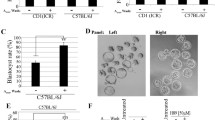Abstract
Purpose: Our goal was to study the activation current in physiologically competent metaphase II human oocytes, i.e., not previously exposed to spermatozoa or aged in vitro, and, in particular, to determine whether a soluble sperm factor triggers a fertilization current comparable to that observed with intact spermatozoa and to characterize the current involved.
Methods: The whole-cell voltage-clamp technique was used on spare metaphase II oocytes, obtained with patient consent from IVF programs. In this configuration a soluble fraction from human spermatozoa was microinjected, and the current recorded.
Results: Metaphase II human oocytes generate bell-shaped outward currents of 400–1000 pA (X=706±322;n=10), following injection of a cytosolic extract from human spermatozoa. The amount of sperm extract injected was less than 10% of the total oocyte volume and was equivalent to 1–10 spermatozoa. A similar current was generated following exposure to 20 µM of the calcium ionophore A23187 (n=10). The steady-state conductance of the oocyte increased from 10 to 19.8 nS (n=10) following injection of the sperm factor and from 5.3 to 27.7 nS following ionophore exposure. Both sperm factor- and ionophore-induced currents were reduced in amplitude when the unfertilized oocyte was preexposed to 25–75 µM iberiotoxin (n=8) and eliminated at a concentration of 100 µM iberiotoxin.
Conclusions: The data support the hypothesis of a soluble sperm factor involved in the activation of human oocytes and shows that the initial activation response in the human oocyte is the gating of Ca2+-activated K+ channels.
Similar content being viewed by others
References
Dale B: Primary and secondary messengers in the activation of ascidian eggs. Exp Cell Res 1988;177:205–211
Dale B, DeFelice LJ, Ehrenstein G: Injection of a soluble sperm extract into sea urchin eggs triggers the cortical reaction. Experientia 1985;41:1068–1070
Stice SL, Robl JM: Activation of mammalian oocytes by a factor obtained from rabbit sperm. Mol Reprod Dev 1990;25:272–280
Swann K: A cytosolic sperm factor stimulates reptitive calcium increases and mimics fertilization in hamster eggs. Development 1990;110:1295–1302
Kline D, Kado R, Kopf G, Jaffe L: Receptors, G-proteins and activation of the amphibian egg.In Mechanism of Fertilization: Plants to Humans, B Dale (ed), Nato Cell Biology Series, H45. Heidelberg, Springer Verlag, 1990, pp 529–541
Foltz KR, Partin JS, Lennarz WJ: Sea urchin egg receptor for sperm: Sequence similarity of binding domain and hsp 70. Science 1993;259:1421–1425
Homa ST, Swann K: A cytosolic sperm factor triggers calcium oscillations and membrane hyperpolarization in human oocytes. Hum Reprod 1994;9(12):2356–2361
Dale B, De Felice LJ: Sperm activated channels in ascidian oocytes. Dev Biol 1984;121:235–239
Dale B: Fertilization channels in ascidian eggs are not activated by Ca. Exp Cell Res 1987;172:474–480
Kline D, Nuccitelli R: The wave of activation current in theXenopus egg. Dev Biol 1985;111:471–487
Miyazaki S, Igusa Y: Fertilization potential in golden hamster eggs consists of recurring hyperpolarizations. Nature Lond 1981;290:706–707
Miyazaki, S: Fertilization potential and calcium transient in mammalian eggs. Dev Growth Diff 1993;30:603–610
Gianaroli L, Tosti E, Magli C, Iaccarino M, Ferraretti AP, Dale B: Fertilization current in the human oocyte. Mol Reprod Dev 1994;38:209–214
Dale B: Fertilization in Animals. London, Edward Arnold, 1983
Dale B: FertilizationIn Human Physiology: From Cellular Mechanism to Integration, R Greger, H Koepchen, W Mommaerts (eds). Heidelberg, Springer Verlag, 1996
Dale B, Gualtieri R, Talevi R, Tosti E, Santella L, Elder K: Intercellular communication in the early human embryo. Mol Reprod Dev 1991;29:22–28
Robertson T: Studies on the fertilization of the eggs of a sea urchinStrongylocentrotus purpuratus by blood sera, sperm extract and other fertilizing agents. Arch Entwicklungs Mech 1912;35:64–130
Jaffe L: Calcium explosions as triggers of development. Ann NY Acad Sci 1980;339:86–101
Iwasa KH, Ehrenstein G, DeFelice LJ, Russell JT: High concentrations of inositol 1,4,5-trisphosphate in sea urchin sperm. Biochem Biophys Res Commun 1990;172:932–938
Swann K: The soluble sperm oscillogen hypothesis. Zygote 1993;1(4):273–276
Tosti E, Palumbo A, Dale B: Inositol tri-phosphate in human and ascidian spermatozoa. Mol Reprod Dev 1993;35:52–56
Whitaker M, Irvine R: Inositol 1,4,5-trisphosphate microinjection activates sea urchin eggs. Nature London 1984;312:636–639
Tosti E, Dale B: Regulation of fertilization channels in ascidian eggs by intracellular second messenger. Mol Reprod Dev 1994;37:473–476
Whitaker M, Swann K: Lighting the fuse at fertilization. Development 1993;117:1–12
Candia S, Garcia ML, Latorre R: Mode of action of iberiotoxin a potent blocker of the large conductance Ca2+-activated K+ channels. Biophys J 1992;65:583–590
Author information
Authors and Affiliations
Rights and permissions
About this article
Cite this article
Dale, B., Fortunato, A., Monfrecola, V. et al. A soluble sperm factor gates Ca2+-activated K+ channels in human oocytes. J Assist Reprod Genet 13, 573–577 (1996). https://doi.org/10.1007/BF02066611
Received:
Accepted:
Issue Date:
DOI: https://doi.org/10.1007/BF02066611




